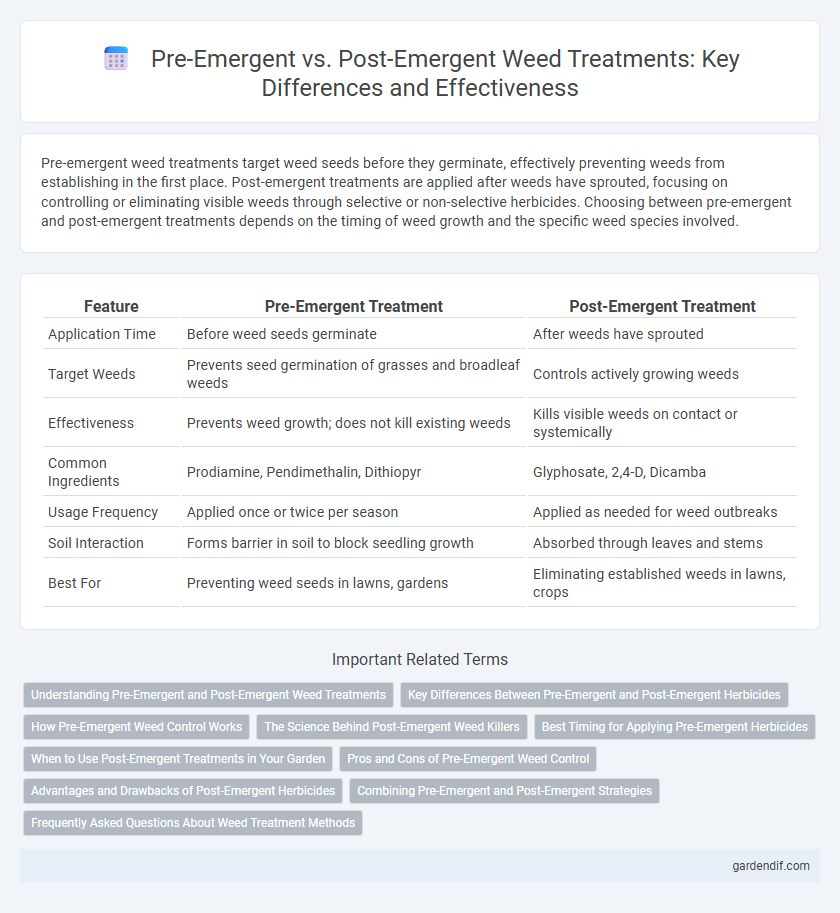
Pre-emergent vs post-emergent treatment Illustration
Pre-emergent weed treatments target weed seeds before they germinate, effectively preventing weeds from establishing in the first place. Post-emergent treatments are applied after weeds have sprouted, focusing on controlling or eliminating visible weeds through selective or non-selective herbicides. Choosing between pre-emergent and post-emergent treatments depends on the timing of weed growth and the specific weed species involved.
Table of Comparison
| Feature | Pre-Emergent Treatment | Post-Emergent Treatment |
|---|---|---|
| Application Time | Before weed seeds germinate | After weeds have sprouted |
| Target Weeds | Prevents seed germination of grasses and broadleaf weeds | Controls actively growing weeds |
| Effectiveness | Prevents weed growth; does not kill existing weeds | Kills visible weeds on contact or systemically |
| Common Ingredients | Prodiamine, Pendimethalin, Dithiopyr | Glyphosate, 2,4-D, Dicamba |
| Usage Frequency | Applied once or twice per season | Applied as needed for weed outbreaks |
| Soil Interaction | Forms barrier in soil to block seedling growth | Absorbed through leaves and stems |
| Best For | Preventing weed seeds in lawns, gardens | Eliminating established weeds in lawns, crops |
Understanding Pre-Emergent and Post-Emergent Weed Treatments
Pre-emergent weed treatments target weed seeds before germination, preventing the sprouting of common lawn invaders such as crabgrass and goosegrass by creating a chemical barrier in the soil. Post-emergent treatments kill actively growing weeds by penetrating leaf tissues, making them effective against visible, established weeds like dandelions and clover. Proper timing and application based on weed life cycles maximize the effectiveness of both pre-emergent and post-emergent herbicides for healthier, weed-free landscapes.
Key Differences Between Pre-Emergent and Post-Emergent Herbicides
Pre-emergent herbicides target weed seeds before they germinate, effectively preventing weed growth by creating a chemical barrier in the soil. Post-emergent herbicides act on established weeds, either by systemic absorption through leaves or contact damage, allowing selective removal of visible weeds. Key differences include timing of application, with pre-emergent applied early in the growing season, and post-emergent used once weeds have emerged, as well as their mode of action and spectrum of control.
How Pre-Emergent Weed Control Works
Pre-emergent weed control works by creating a chemical barrier in the soil that inhibits weed seed germination and prevents root development before the weeds emerge. This targeted approach disrupts the early growth stages of common weeds like crabgrass and chickweed, reducing competition for nutrients and water. Effective timing of application, usually in early spring or fall, ensures maximum protection against invasive weed species.
The Science Behind Post-Emergent Weed Killers
Post-emergent weed killers target actively growing weeds by disrupting vital physiological processes such as photosynthesis, cell division, or hormone regulation, enabling rapid control of visible weeds. These herbicides are absorbed through the leaves and translocated throughout the plant, ensuring systemic action that kills both foliage and roots to prevent regrowth. Understanding the mode of action, including selective or non-selective targeting, improves treatment efficacy and helps manage herbicide resistance in weed populations.
Best Timing for Applying Pre-Emergent Herbicides
Pre-emergent herbicides are most effective when applied before weed seeds germinate, typically in early spring or late fall depending on the weed species and local climate. Timing is crucial because these herbicides form a chemical barrier in the soil that prevents weed seedlings from emerging but will not control established weeds. Applying pre-emergent treatments too early can reduce effectiveness due to degradation, while applying too late allows weeds to establish and evade control measures.
When to Use Post-Emergent Treatments in Your Garden
Post-emergent treatments are most effective when weeds have already sprouted and are actively growing, allowing the herbicide to be absorbed through the foliage for targeted control. Apply post-emergent herbicides during calm, dry weather to maximize adherence and penetration, avoiding early morning or late evening applications to reduce dew interference. Choose selective formulations for broadleaf weeds or non-selective options for tougher infestations, ensuring minimal impact on desirable plants in your garden.
Pros and Cons of Pre-Emergent Weed Control
Pre-emergent weed control prevents weed seeds from germinating by creating a chemical barrier in the soil, making it highly effective for early weed management and minimizing future labor. However, it does not affect existing weeds, requiring precise timing and thorough application to avoid ineffective results. Pre-emergent herbicides are valuable for maintaining weed-free lawns but can limit planting options and may require repeated applications for sustained control.
Advantages and Drawbacks of Post-Emergent Herbicides
Post-emergent herbicides effectively target actively growing weeds, providing quicker visible results and the ability to control established weed populations. These treatments allow selective application, minimizing damage to desirable plants, but may require multiple applications due to resistance or incomplete coverage. Drawbacks include higher susceptibility to weather conditions and limited effectiveness against dormant or mature weed roots, potentially necessitating integration with other weed management strategies.
Combining Pre-Emergent and Post-Emergent Strategies
Combining pre-emergent and post-emergent weed treatments effectively controls both existing weeds and prevents new ones from germinating, optimizing lawn health and appearance. Pre-emergent herbicides create a chemical barrier that disrupts weed seed germination, while post-emergent treatments target visible weeds through selective or non-selective active ingredients. Integrating these strategies ensures comprehensive weed management, reducing the need for repeated herbicide applications and minimizing chemical resistance.
Frequently Asked Questions About Weed Treatment Methods
Pre-emergent herbicides prevent weed seeds from germinating by creating a chemical barrier in the soil, making them effective before weeds appear. Post-emergent treatments target actively growing weeds, allowing spot treatment of visible weeds without harming the surrounding grass or plants. Understanding the timing, application methods, and specific weed types each treatment controls helps optimize weed management strategies for lawns and gardens.
Pre-emergent vs post-emergent treatment Infographic

 gardendif.com
gardendif.com